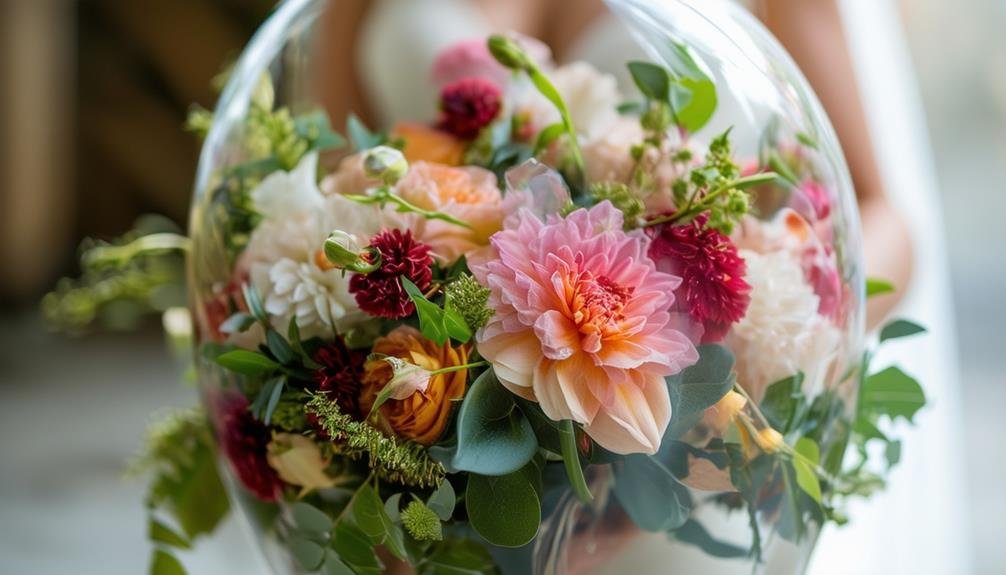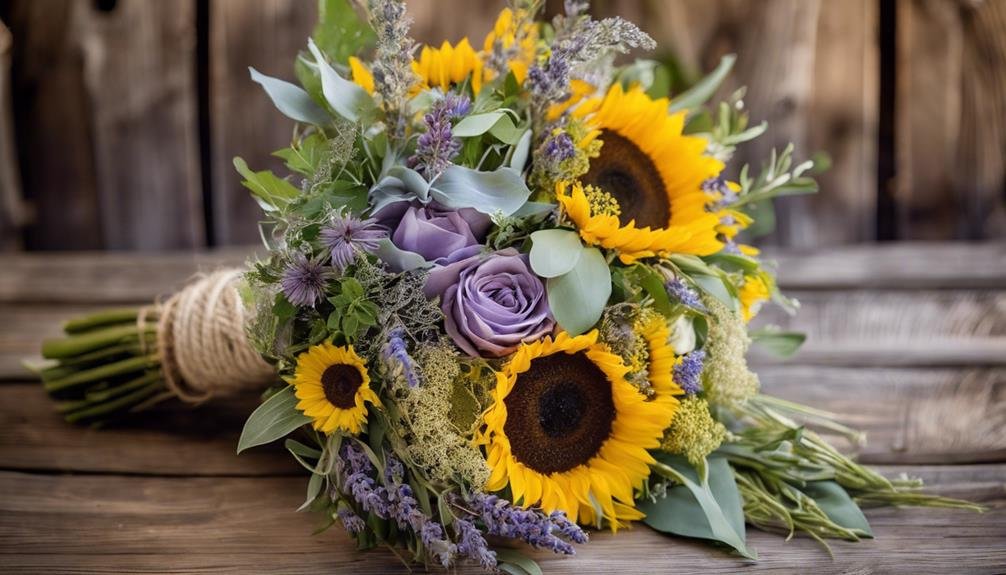Preserving your wedding bouquet can transform ephemeral flowers into timeless keepsakes. Air drying is a chemical-free method where bouquets are hung upside down in a dark area. Pressing flowers between books offers cost-effective, delicate botanical art. Silica gel preservation retains vibrant colours and delicate petal structures efficiently. Wax preservation involves coating flowers in melted paraffin, adding a unique texture. Freeze-drying, a high-tech method conducted by professionals, meticulously maintains the original look of the bouquet. Lastly, resin encapsulation seals dried flowers in clear, durable resin, creating a beautiful, lasting memento. Discover further details on these preservation methods for lasting memories.
Main Points
- Air drying preserves wedding bouquets naturally by hanging them upside down in a dry, dark area, maintaining their original shape and colour.
- Pressed flowers transform bouquets into delicate botanical art by flattening and drying flowers between absorbent paper and heavy books.
- Silica gel preservation ensures vibrant colour and delicate petal structure, completing the process within 1-7 days for professional-quality results at home.
- Freeze-drying maintains the original appearance of wedding bouquets by meticulously removing moisture in a vacuum chamber, preserving shape, colour, and texture.
- Resin encapsulation seals dried flowers in clear, durable resin, creating timeless keepsakes that can be displayed decoratively or crafted into jewellery.
Air Drying: Natural Bouquet Preservation Option
Air drying is a natural and cost-effective method for preserving wedding bouquets, offering a chemical-free approach to maintaining the beauty and sentimentality of your flowers. This technique harnesses the simplicity of nature, providing an accessible option for those who wish to keep their cherished flower arrangement intact. The drying process involves hanging the bouquet upside down in a dry, dark area, which allows the flowers to gradually lose their moisture while maintaining their original shape and colour. The hanging method is straightforward and ideal for DIY projects. To start, gather your bouquet and tie the stems together with a piece of string or ribbon. Find a suitable location, such as a closet or attic, where the flowers can be undisturbed by moisture or direct sunlight. Suspended upside down, the bouquet will slowly dehydrate over the course of 2-4 weeks. This timeline ensures that the flowers dry thoroughly, resulting in a preserved arrangement that can be displayed as a lasting memento. Natural preservation through air drying retains the aesthetic qualities of your wedding flowers and allows you to engage in a hands-on, personal preservation process. This method is perfect for those who appreciate the value of DIY projects and wish to imbue their preservation efforts with a touch of personal craftsmanship. By following these simple steps, you can transform your wedding bouquet into a timeless keepsake, celebrating the beauty and sentimentality of your special day without the need for guaranteeing chemical interventions.
Silica Gel Preservation for Wedding Flowers

For those seeking a more controlled and efficient method of preserving their wedding bouquet, silica gel offers a highly effective solution. This desiccant, renowned for its moisture-absorbing properties, guarantees that flowers retain their vibrant colour and delicate petal structure with remarkable precision. Silica gel’s primary advantage lies in its swift drying time, often completing the preservation process within 1-7 days. This rapid drying not only prevents the flowers from wilting but also maintains the intricate details of your bouquet, making it an ideal choice for preserving delicate flowers and complex arrangements. The silica gel gently removes moisture from the petals, preserving the bouquet’s natural beauty and sentimental value. One of the key benefits of using silica gel is its reusability. After each use, silica gel can be reactivated by heating it in an oven, making it an eco-friendly and cost-effective choice for multiple preservation projects. This reusability benefit ensures that your investment in preserving your wedding bouquet can extend to other cherished floral arrangements in the future. For those who enjoy hands-on projects, the DIY convenience of silica gel preservation cannot be overstated. This method allows you to achieve professional-quality results from the comfort of your home. By following simple, straightforward instructions, you can transform your bouquet into a lasting keepsake, capturing the essence of your special day with minimal effort.
Freeze-Drying: High-Tech Bouquet Preservation Method
Freeze-drying, a high-tech preservation method, effectively maintains the original appearance of wedding bouquets by meticulously removing moisture from the flowers. This advanced technique ensures that your bouquet remains as vibrant and lifelike as the day you walked down the aisle, offering a cherished keepsake that endures through time. The preservation process begins with careful flower preparation. Ensuring the flowers are in full bloom is essential, as this stage captures their peak beauty. Professional florists typically handle this task, guaranteeing each flower is perfectly prepped. This involves recutting the stems and removing any excess leaves, which can interfere with the moisture removal process. Before the flowers are subjected to freeze-drying, they are soaked in water for approximately 12 hours, allowing them to be fully hydrated at the start of the process. Once prepared, the flowers undergo an intricate freeze-drying process. This involves freezing the bouquet and then placing it in a vacuum chamber. Here, the moisture is sublimated directly from ice to vapour, bypassing the liquid phase entirely. This meticulous method of moisture removal is what allows the flowers to retain their original shape, colour, and texture. Utilizing a professional service for freeze-drying ensures that each step is executed with precision and care. The result is a bouquet that looks as if it were freshly picked, capturing the magic of your wedding day for years to come. This high-tech method of preservation is ideal for those seeking to maintain the full beauty and sentimentality of their wedding flowers indefinitely.
Pressed Flowers: Classic Bouquet Preservation

While the advanced technique of freeze-drying offers a modern approach to flower preservation, the timeless art of pressing flowers provides a classic and elegant alternative. Pressing flowers is a method steeped in tradition and simplicity, making it an enduring choice for those looking to preserve their wedding bouquets. Pressed flowers involve carefully flattening and drying flowers between absorbent paper and heavy books. This technique not only maintains the shape and colour of the flowers but also transforms them into delicate pieces of botanical artistry. Such preserved flowers can be beautifully framed or used in various creative crafts, offering multiple sentimental keepsakes. For those who enjoy DIY projects, pressing flowers is a cost-effective and straightforward method to safeguard the memories of a special day. Here’s a step-by-step guide to help you get started:
- Select Fresh Flowers: Choose flowers from your bouquet at their peak freshness to guarantee the best results.
- Prepare the Flowers: Trim the stems and remove any excess foliage. Arrange the flowers flat on absorbent paper.
- Press the Flowers: Place the flowers between heavy books or in a flower press. Ensure even pressure for consistent results.
- Wait and Store: Allow the flowers to dry completely, which can take a few weeks. Once dried, consider framing options to display your botanical artistry.
Pressed flowers can last for years when stored properly, making them a timeless keepsake for your special day. Whether showcased in a beautiful frame or used in various creative crafts, pressed flowers offer a unique and enduring way to cherish your wedding memories.
Resin Encapsulation for Wedding Bouquets

Resin encapsulation offers a modern and striking method for preserving wedding bouquets by sealing dried flowers in clear, durable resin. This technique transforms your cherished wedding flowers into timeless keepsakes, capturing the essence of your special day forever. To create a flawless preserved bouquet, it is important to use bubble-free resin. This guarantees the encapsulated flowers remain perfectly visible, free from unsightly air pockets. Begin by drying your bouquet thoroughly, as moisture can interfere with the resin curing process. Once dried, carefully plan your flower arrangement to highlight the most sentimental blooms. The next step involves selecting a clear mould, which will serve as the container for your resin and flowers. Silicone moulds are ideal due to their flexibility and ease of use. Pour a thin layer of resin into the mould and allow it to partially cure before placing the flowers. This partial curing step helps to anchor the flowers in place, preventing them from floating to the surface. After arranging the flowers within the mould, slowly pour additional resin to fully encapsulate them. It is essential to pour gradually to maintain a bubble-free resin environment, ensuring a pristine final product. Allow the resin to cure completely, following the manufacturer’s guidelines for best results. The result is a beautiful, durable piece that preserves your wedding memories in a unique and artistic form. Whether displayed as a decorative piece or crafted into jewellery, resin encapsulation offers a lasting tribute to one of the most significant days of your life.
Wax Preservation: Unique Flower Safeguarding

Wax preservation offers a distinctive method for extending the lifespan of your wedding bouquet by dipping the flowers in melted paraffin wax. This technique, known as flower dipping, is an excellent choice for those who wish to maintain the beauty and form of their blooms for up to six months, providing a unique and temporary decorative display. To achieve best results with wax preservation, follow these steps:
- Prepare the Flowers: Select fresh flowers that are in peak condition. Avoid using blooms that are already wilting or discoloured, as these will not hold up well during the wax coating process.
- Melt the Wax: Use paraffin wax, heating it slowly until fully melted. Make sure the wax is hot enough to coat the flowers evenly but not so hot that it damages them.
- Dip the Flowers: Carefully dip each flower into the melted wax, making sure that all petals and leaves are thoroughly coated. This step, known as flower dipping, is important for sealing in the flowers’ natural beauty.
- Hang to Dry: Once dipped, hang the flowers upside down to dry completely. This prevents the wax from pooling and helps maintain the flowers’ shape and integrity.
Wax preservation not only extends the longevity of your bouquet but also adds a unique texture and sheen to your flowers. The wax coating creates a protective barrier that helps prevent wilting and fading, allowing your bouquet to remain a cherished keepsake. While this method is ideal for short-term display, it offers a beautiful solution for preserving your wedding day memories distinctively and decoratively.
Conclusion
Preserving a wedding bouquet offers a lasting tribute to a significant life event, with various methods available to suit different needs and preferences. Techniques such as air drying, silica gel preservation, freeze-drying, pressing, resin encapsulation, and wax preservation each provide distinct benefits and outcomes. By exploring these options, couples can select the most suitable method to transform their wedding flowers into a cherished, enduring keepsake that captures the essence and beauty of their special day.

